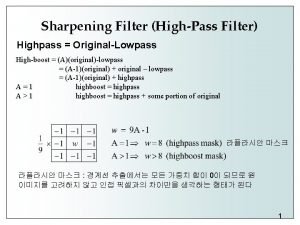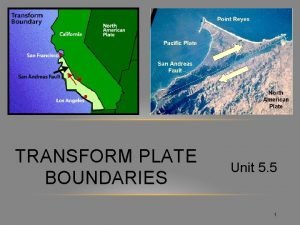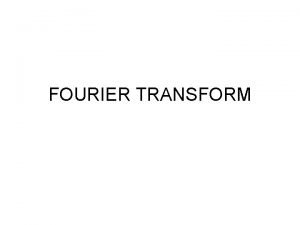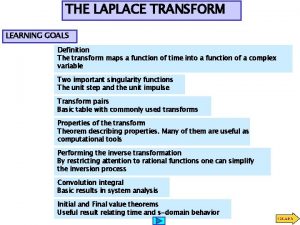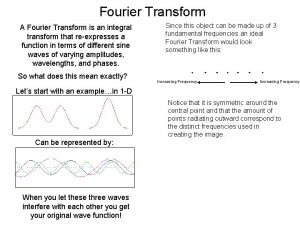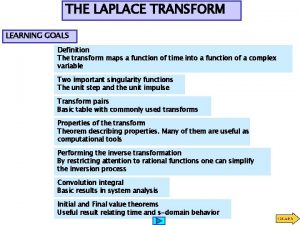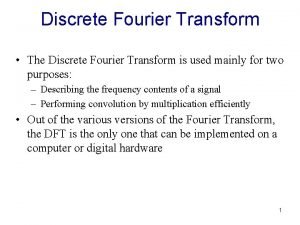Sharpen Your Trading with the Fisher Transform Presented



























- Slides: 27

Sharpen Your Trading with the Fisher Transform Presented by John Ehlers


Technical Analysis is Based on Probability “The market is oversold because the Stochastic has been high, so when it crosses through 80 then. . . ” “When the head-and-shoulders pattern is complete then. . . ” “When the market breaks above the upper channel then. . . ” Why fool around with rules? Let’s attack probability directly

Gaussian Probability Distribution Function is Commonly Assumed for Market Data Gaussian PDF Cumulative. Gaussian PDF 0 = 50% +1 s = 85% +2 s = 98% +3 s = 99. 9% Gaussian PDF is attractive because it can be achieved using several random variables due to the central limit theorem But is Gaussian the right PDF for market data?

The PDF Depends on the Market Waveshape Square Wave Sine Wave Binary PDF of Square Wave Sine Wave PDF

How Do We Determine the Market PDF? Create the waveform by stringing beads on a horizontal wire frame Rotate wire frame to enable beads to stack up Height of the bead stacks is the PDF of the Waveform

Code to Generate PDF Inputs: Price((H+L)/2), Len(10); Vars: Max. H(0), Min. L(0), count(0), I(0); Arrays: PDF[100](0); Max. H = Price; Min. L = Price; For count = 0 to Len - 1 begin If Price[count] > Max. H then Max. H = Price[count]; If Price[count] < Min. L then Min. L = Price[count]; End; Value 1 =. 5*((Price - Min. L)/(Max. H - Min. L)) +. 5*Value 1[1]; For I = 0 to 100 begin If Value 1 >= I/100 and Value 1 < I/100 +. 01 then PDF[I] = PDF[I] + 1; End; If Last. Bar. On. Chart then begin For I = 0 to 100 begin Print(File("C: TSGrowthUSPDF. CSV"), I/100, ", ", PDF[I]); End;

PDF for Treasury Bonds 10 Bar Channel over 15 Years 30 Bar Channel over 15 Years

The Fisher Transform

The Purpose of the Fisher Transform is to Change Values that Result In a Gaussian PDF The Fisher Transform Equation The Fisher Transform inputs must be limited between -1 and +1 The Fisher Transform Transfer Response is Expansive

Sinewave PDF is Converted To Be Nearly Gaussian by the Fisher Transform

Fisher Transform Code Inputs: Price((H+L)/2), Len(10); Vars: Max. H(0), Min. L(0), count(0), Fish(0); Max. H = Price; Min. L = Price; For count = 0 to Len - 1 begin If Value 2[count] > Max. H then Max. H = Price[count]; If Value 2[count] < Min. L then Min. L = Price[count]; End; Value 1 =. 5*2*((Price - Min. L)/(Max. H - Min. L) -. 5) +. 5*Price[1]; If Value 1 >. 999 then Value 1 =. 999; If Value 1 < -. 999 then Value 1 = -. 999; Fish =. 25*Log((1 + Value 1)/(1 - Value 1)) +. 5*Fish[1]; {Plot 1(Fish, "Fisher"); Plot 2(. 9*Fish[1], ”Trigger");

The Fisher Transform Indicator Gives Sharper and More Timely Turning Point Signals than Most Other Indicators

Fisher Transform Strategy Inputs: Price((H+L)/2), Len(10); Vars: Max. H(0), Min. L(0), count(0), Fish(0); Value 2 = Price; Max. H = Value 2; Min. L = Value 2; For count = 0 to Len - 1 begin If Value 2[count] > Max. H then Max. H = Value 2[count]; If Value 2[count] < Min. L then Min. L = Value 2[count]; End; Value 1 =. 5*2*((Value 2 - Min. L)/(Max. H - Min. L) -. 5) +. 5*Value 1[1]; If Value 1 >. 9999 then Value 1 =. 9999; If Value 1 < -. 9999 then Value 1 = -. 9999; Fish =. 5*Log((1 + Value 1)/(1 - Value 1)) +. 5*Fish[1]; If Fish[1] < -3 and Fish Crosses Over. 9*Fish[1] then Sell Next Bar on Open; If Fish[1] > 3 and Fish Crosses Under. 9*Fish[1] then Buy Next Bar on Open; Idea is to find a trend and then enter a pop in the direction of the trend

DX Performance - Len=4

EC Performance - Len=24

JY Performance - Len=11

SF Performance - Len=7

The Inverse Fisher Transform

The Stochastic RSI is a Popular Indicator First take a standard RSI Next, compute the Stochastic of that RSI Smooth the result with a Weighted Moving Average Typical parameters are: 8, 8, 5 Stochastic RSI Easy. Language Code

The Stochastic RSI Gives Signals in a Timely Manner

Deriving the Inverse Fisher Transform The original Fisher Transform Take the inverse by exponentiating both sides and rearranging for X Interchange x and y for conventional notation of input and output The Inverse Fisher Transform is Compressive

Inverse Fisher RSI Code Inverse Fisher Transform requires the input amplitude be reasonably limited A recentered and rescaled RSI fills the bill Vars: IFish(0); Value 1 =. 1*(RSI(Close, 5) - 50); Value 2 = WAverage(Value 1, 9); IFish = (Exp. Value(2*Value 2) - 1) / (Exp. Value(2*Value 2) + 1); Plot 1(IFish, "IFish"); Plot 2(0. 5, "Sell Ref"); Plot 3(-0. 5, "Buy Ref");

The Inverse Fisher Transform Crossing the Trigger Levels Gives Consistently Profitable Trades

The Inverse Fisher Transform Can Also Be Applied to a Variety of Other Indicators My Cyber. Cycle is just one such example from “Cybernetic Analysis for Stocks and Futures” Inputs: Price((H+L)/2), alpha(. 07); Vars: Smooth(0), Cycle(0), ICycle(0); Smooth = (Price + 2*Price[1] + 2*Price[2] + Price[3])/6; Cycle = (1 -. 5*alpha)*(Smooth - 2*Smooth[1] + Smooth[2]) + 2*(1 - alpha)*Cycle[1] - (1 – alpha)*(1 - alpha)*Cycle[2]; If currentbar < 7 then Cycle = (Price - 2*Price[1] + Price[2]) / 4; ICycle = (Exp. Value(2*Cycle) - 1) / (Exp. Value(2*Cycle) + 1); Plot 1(ICycle, "Cycle"); Plot 2(0. 5, "Sell Ref"); Plot 3(-0. 5, "Buy Ref");

The Inverse Fisher Transform Helps Eliminate Some Whipsaw Trades

SUMMARY The Fisher Transform and Inverse Fisher Transform introduce no lag The Fisher Transform readjusts the data PDF to give sharp turning point indications The Fisher Transform Strategy identifies trends and pops in the direction of the trend The Inverse Fisher Transform is an elegant means to improve many existing indicators
 Ehler fisher transform strategy
Ehler fisher transform strategy Sharpen the saw soul
Sharpen the saw soul Sharpen the saw soul
Sharpen the saw soul Sharpen your soul
Sharpen your soul Sharpen your saw story
Sharpen your saw story Non trading organisation definition
Non trading organisation definition Sharpen the saw examples
Sharpen the saw examples Maturity continuum victories
Maturity continuum victories Sharpen the saw reflection
Sharpen the saw reflection Habit 7 sharpen the saw worksheet
Habit 7 sharpen the saw worksheet Scanning lens
Scanning lens Moves the stage slightly to sharpen the image.
Moves the stage slightly to sharpen the image. Hans zacharias janssen
Hans zacharias janssen Moves the stage slightly to sharpen the image
Moves the stage slightly to sharpen the image Moves the stage slightly to sharpen the image
Moves the stage slightly to sharpen the image Filter sharpen
Filter sharpen Once upon a time there lived a woodcutter
Once upon a time there lived a woodcutter See-do-get
See-do-get Moves the stage slightly to sharpen the image.
Moves the stage slightly to sharpen the image. What does sharpen the saw mean
What does sharpen the saw mean Sharpen the saw meaning
Sharpen the saw meaning Give us your hungry your tired your poor
Give us your hungry your tired your poor Example of news headline
Example of news headline Presentation by name
Presentation by name Dr. jekyll and mr. hyde setting
Dr. jekyll and mr. hyde setting Romeo and juliet love themes
Romeo and juliet love themes Dentify a key term used in both passages.
Dentify a key term used in both passages. Name/title of presenter
Name/title of presenter















